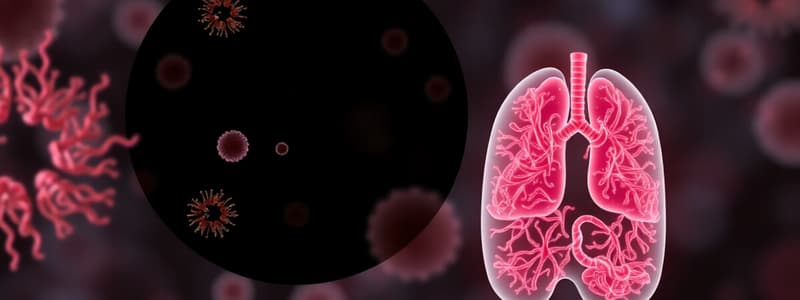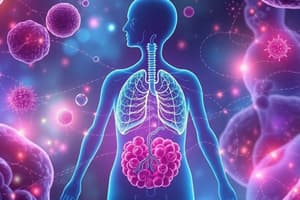Podcast
Questions and Answers
What is produced in the anaerobic pathway when oxygen is limited?
What is produced in the anaerobic pathway when oxygen is limited?
- Carbon dioxide
- Glucose
- Acetic acid
- Lactic acid (correct)
Anaerobic respiration occurs in all cells regardless of the presence of oxygen.
Anaerobic respiration occurs in all cells regardless of the presence of oxygen.
False (B)
What is the net energy yield from anaerobic glycolysis?
What is the net energy yield from anaerobic glycolysis?
2 ATP
In aerobic respiration, pyruvate enters the _______ cycle.
In aerobic respiration, pyruvate enters the _______ cycle.
Match the following processes with their respective outputs:
Match the following processes with their respective outputs:
Which of the following correctly describes the role of NAD+ in glycolysis?
Which of the following correctly describes the role of NAD+ in glycolysis?
Erythrocytes can perform aerobic respiration due to the presence of mitochondria.
Erythrocytes can perform aerobic respiration due to the presence of mitochondria.
What is the terminal electron acceptor in aerobic respiration?
What is the terminal electron acceptor in aerobic respiration?
Flashcards
Anaerobic Respiration
Anaerobic Respiration
Energy production in the absence of oxygen, where pyruvate is converted into lactic acid. This process generates ATP, keeps pyruvate levels low for continued glycolysis, and oxidizes NADH to NAD+.
Lactic Acid
Lactic Acid
A byproduct of anaerobic respiration. It is produced when pyruvate is converted in the absence of oxygen.
NAD+ Regeneration
NAD+ Regeneration
In anaerobic respiration, NADH is oxidized back into NAD+ by converting pyruvate to lactic acid. This is crucial for glycolysis to continue.
Cori Cycle
Cori Cycle
Signup and view all the flashcards
Aerobic Respiration
Aerobic Respiration
Signup and view all the flashcards
Krebs Cycle
Krebs Cycle
Signup and view all the flashcards
Electron Transport Chain
Electron Transport Chain
Signup and view all the flashcards
Oxygen as Terminal Electron Acceptor
Oxygen as Terminal Electron Acceptor
Signup and view all the flashcards
Study Notes
Anaerobic Respiration
- When oxygen is limited or absent, pyruvate enters an anaerobic pathway, converting to lactic acid.
- This pathway generates additional ATP, keeping pyruvate levels low to sustain glycolysis.
- NADH is oxidized to NAD+, crucial for glycolysis.
- Lactic acid replaces oxygen as the final electron acceptor.
- Occurs in most body cells lacking oxygen or functioning mitochondria, like red blood cells.
- Effective for short-term ATP production (seconds to minutes).
- Lactic acid diffuses into the bloodstream, processed by the liver back to pyruvate or glucose (Cori cycle).
- In exercise, muscles rely on rapid ATP production via glycolysis and lactic acid generation when oxygen delivery is inadequate.
- The net energy yield of glucose oxidation via anaerobic glycolysis is 2 ATP.
Aerobic Respiration
- With oxygen present, pyruvate enters the Krebs cycle.
- Energy is extracted as electrons are transferred from pyruvate to NAD+, GDP, and FAD producing carbon dioxide.
- NADH and FADH2 donate electrons to the electron transport chain.
- The electron transport chain uses this energy to generate ATP.
- Oxygen acts as the terminal electron acceptor, creating water.
- The net energy yield of glucose oxidation via aerobic glycolysis is 2 ATP + 2 NADH + H = 2ATP + (2 x 3 ATP) = 8 ATP.
Studying That Suits You
Use AI to generate personalized quizzes and flashcards to suit your learning preferences.




